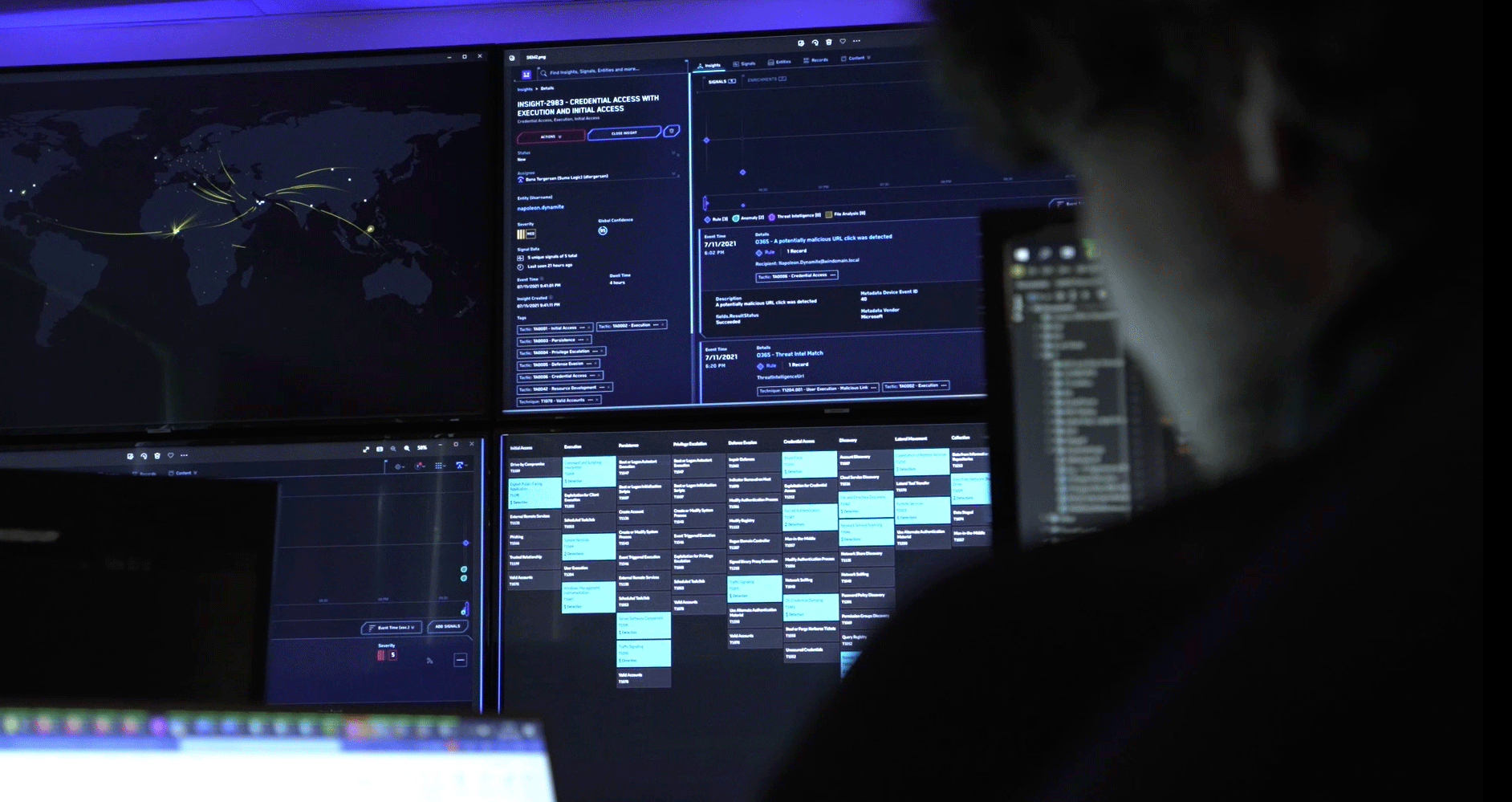Network Detection & Response (NDR)
Protect your business with hybrid network detection, response and security compliance.

Network Detection and Response (NDR) continuously monitors network traffic
NDR tools use artificial intelligence, machine learning and behavioural analytics to provide a baseline of activity which can be used to track any malicious or anomalous activity and identify potential threats. This continuous analysis evolves with the network, ensuring that it is always up to date.
It is designed to identify threats that evade endpoint security or signature-based defences by observing lateral movement, command & control traffic, unusual inter-device communications, and other network anomalies.

What is Network Detection & Response (NDR)?
NDR is a modern cyber defence strategy that continuously monitors and analyses network traffic patterns to detect suspicious activity that traditional perimeter tools miss.
NDR applies machine learning, threat intelligence, and behavioural analytics to identify lateral movement, command-and-control activity, and insider threats before they escalate into incidents.

What does Network Detection & Response (NDR) do?
Previously, Network Traffic Analysis (NTA) was the established method of monitoring company’s networks, however, as cyber-criminals became more advanced, there came a need for a more innovative solution. NDR technology builds on the capabilities of NTA by adding behavioural analysis and threat response. Gartner renamed the solution ‘NDR’ in 2020 as a more relevant description of what NDR does.
The type of cybersecurity risks NDR searches for include unknown malware, targeted attacks, insider attacks, and risky behaviour.

Why do you need Network Detection & Response (NDR)?
Traditional threat detection security tools operate by looking for unique Indicators of Compromise (IoCs) and signatures. They can identify these from the line of code, file hash, or size of the malware variant. This information is updated in databases and means that threats can be detected by scanning for the presence of these signatures in network traffic.
However, this is very limiting. These tools cannot detect new or unknown malware or threats because they can only identify threats that they already know. They are detection-focused, which is no longer effective against modern cyber security threats. In contrast, NDR solutions are dynamic, so they can actively hunt for threats. This makes them essential to maintaining a healthy network security. Even when a threat is unknown, NDR technology can identify it and alert the security team, so protecting the entire network. NDR solutions provide incident response automation and security tools, alerting SOC teams to potential malicious activity and running automated responses to optimise threat investigations and minimise impact. Overall, these systems ensure increased visibility across the network.
NDR provides security teams with broad attack visibility and knowledge of potential threats, which means that false negatives are largely avoided. As well as this, it provides additional analytical data, which lead to increased accuracy in threat detection. By using technology such as behavioural analytics and AI, NDR provides more precise and accurate threat hunting, as well as out-of-the-box detection.
NDR is more efficient than alternative solutions. Cyber threats are detected early on, and mitigated before damage can be done to the network. Cloud-delivered analytics has increased access for remote workers which has grown in importance for our current cyber landscape.
The SOC visibility triad
Having an NDR solution complements the ‘SOC visibility triad’ (Network Detection and Response (NDR), Endpoint Detection and Response (EDR), and Security Information and Event Management (SIEM)) which ensures a completely protected security portfolio as security teams are provided with all the necessary tools to hunt threats.
Network Detection & Response (NDR) best practices
To get the most from Network Detection & Response (NDR), organisations need a strategy. Establishing full visibility, building baselines, fine-tuning detection rules, and integrating with SIEM or EDR platforms all ensure stronger security. Combined with automation and staff training, these best practices turn NDR into a powerful defence against advanced network threats.
Establish best practises for your organisation to maintain an optimal NDR solution.
| Identifies which assets on your network are not protected |  |
| Uses AI and Machine Learning |  |
| Captures and analyses IoT device traffic |  |
| Detects Man-in-the-middle attacks |  |
| Continually monitors network traffic |  |

NDR from Red Helix
Our service complements our Endpoint Detection & Response (EDR) service, supporting your IT team by protecting your infrastructure from cyber-attacks, ransomware, and internal threats.
We provide comprehensive network detection, response, and compliance across your network infrastructure, protecting you from attacks that can bypass Anti-Virus and EDR solutions, which rely heavily on signature and threat intelligence updates to be effective. Full network visibility requires both NDR and EDR.
NDR leverages innovative artificial intelligence (AI) and machine learning (ML) technology and a cloud-native architecture, taking NetFlow for traffic analytics with log data from cloud providers, Active Directory logs, as well as application events from Office365 and G-Suite, correlating them against a variety of AI models to achieve maximum coverage. Using AI/ML, NDR can detect threats and associate them down to devices and user accounts. Our service reduces high volume network traffic into prioritised alerts, remediation activities, and threat & compliance reports.
NDR monitors the network continuously giving you network visibility across your infrastructure, providing a real-time asset inventory, able to detect abnormal network activity, rogue and unprotected devices, threats to IoT devices, unprotected ports, with compliance reporting covering NIST, Cyber Essentials, FFIEC, NIAC, CMMC, and more.
Get in touch| Network Detection & Response (NDR) tools |
|---|
| AI & Machine Learning analytics |
| Deep Packet Inspection |
| Threat intelligence integration |
| Network Traffic Analysis |
| Automated incident response |
| Deception technology & Honeypots |
| Cloud & IoT security monitoring |
Our NDR managed service supports your IT team by protecting your hybrid infrastructure from cyber attacks, ransomware and internal threats.
Stop attacks
We detect and stop cyber threats that target your infrastructure. We’ll also monitor your VPNs, directories and cloud platforms and respond when needed. Our service can be deployed quickly and easily to keep pace with your growing infrastructure.
Identify threats
Breaches don’t just come from cyber criminals. Accidental or malicious internal actions can be just as damaging. We analyse networks to look for anomalous activity, unsanctioned devices, missed software patches, unprotected ports, and other things that can leave you vulnerable to attack.
Show compliance
Let us track SLAs and show your Cyber Essentials adherence. We can also tailor reports as and when you need them. Need to demonstrate compliance with international standards like NIST and CMCC? We’ve got you covered.
Benefits of Managed NDR
Get full visibility into every connection, device, and application across your network.
AI and expert human analysts cut through noise to spot real threats in real time.
Stop intruders before they can move laterally or exfiltrate data.
Automated reporting and audit trails support governance frameworks and regulator requirements.
Eliminate alert fatigue and gain actionable insights that drive faster decision-making.
Alerts are triaged, verified, and responded to by Red Helix’s UK-based analysts.
Regular reports, tuning, and proactive improvements ensure long-term resilience.
Watch the video to explore the tools which underpin our service
Managed NDR
At Red Helix, we have your needs covered.
- Review and prioritisation of actionable insights, investigating details to determine the type and severity of a threat to determine the action that needs to be taken.
- Management of policies to ensure your NDR solution setup is tailored to your organisation.
- Incident response tailored to your organisation.
- Daily checks to ensure your NDR instance is configured and functioning correctly.
- Weekly in-depth reviews and fine tuning of your NDR instance to improve your security posture.
FAQs
NDR solutions alert security teams to the potential presence of threats within their environment. This is done by continuously monitoring and analysing networks to generate a baseline of normal network behaviour, this is used as a comparison to detect suspicious traffic.
Network Detection and Response.
- Rapid threat detection, reducing the time actors can dwell in a network.
- Provides expert capabilities to fill the cyber skills shortage, and defend against the latest cyber tactics and techniques..
- Reduces the complexity of siloed approaches as it can be implemented into existing infrastructures.
- Visibility into cloud environments.
No, NDR complements EDR. EDR sees endpoint behaviour whereas NDR sees network traffic and lateral movement.
Deployment can be achieved in days, with full integration into your existing infrastructure and SOC workflows.






